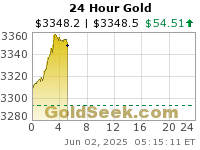This post will be brief as I haven't time this morning to write much.
The US Dollar (/DX) is most likely playing a familar game with investor's psyche at the moment. Here is a chart of the buck from 2010 to present.
 |
| Click on any chart to ENLARGE |
And so, here we go again - but perhaps things will settle down sooner than 'last time'.
The bull will win any battle he choses to get involved with, but on his own timetable. And remember, it is the bull's market.











![[Most Recent Quotes from www.kitco.com]](http://www.kitconet.com/images/quotes_special.gif)



